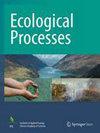Physiological responses and algae inhibition of Pontederia cordata to simulated eutrophication and acid rain co-pollution
IF 3.9
2区 环境科学与生态学
Q1 ECOLOGY
引用次数: 0
Abstract
Eutrophication and acid rain are two threats that many water bodies must contend with. Eutrophication and climate change have accelerated widespread outbreaks of cyanobacterial blooms as both have become more severe. Pontederia cordata, a garden ornamental plant, can inhibit some algae growth and remove total nitrogen (TN) and total phosphorus (TP) from the water. In this study, we investigated how simulated acid rain and eutrophication co-pollution affected P. cordata's growth physiology and ability to inhibit algae growth. Under mild eutrophication (2 mg·L−1 TN, 0.4 mg·L−1 TP, and 15 mg·L−1 CODMn) or weak acid rain (pH = 5.0), P. cordata alleviated the degree of cell membrane lipid peroxidation by stabilizing superoxide dismutase (SOD) and catalase (CAT) activities in the leaves, allowing for normal plant growth. Under mild eutrophication and acid rain conditions, cultured P. cordata water samples maintained strong algae inhibition by reducing the Chl a content and SOD activity of Microcystis aeruginosa cells. Compound stress where acid rain was the primary inhibitory factor along with moderate or severe eutrophication inhibited P. cordata growth, which probably reduced the input of algae-inhibiting allelochemicals, thus reducing its ability to inhibit algae. In summary, P. cordata has application potential in mild eutrophic water and acid rain (pH ≥ 4). These findings provide guidance for further research on phytoremediation and algae control in scenarios of compound pollution.鱼尾草对模拟富营养化和酸雨共污染的生理响应及藻类抑制
富营养化和酸雨是许多水体必须应对的两大威胁。富营养化和气候变化加速了蓝藻爆发的大范围爆发,因为两者都变得更加严重。Pontederia cordata是一种园林观赏植物,具有抑制部分藻类生长和去除水中总氮(TN)和总磷(TP)的作用。在本研究中,我们研究了模拟酸雨和富营养化共同污染如何影响P. cordata的生长生理和抑制藻类生长的能力。在轻度富营养化(2 mg·L−1 TN、0.4 mg·L−1 TP和15 mg·L−1 CODMn)或弱酸雨(pH = 5.0)条件下,草芥通过稳定叶片超氧化物歧化酶(SOD)和过氧化氢酶(CAT)活性,减轻了细胞膜脂过氧化程度,保证了植株的正常生长。在轻度富营养化和酸雨条件下,培养的海藻水样通过降低铜绿微囊藻细胞的Chl a含量和SOD活性,保持了较强的抑藻作用。以酸雨为主要抑制因子的复合胁迫加上中度或重度富营养化,抑制了P. cordata的生长,这可能减少了抑藻化感物质的输入,从而降低了其抑藻能力。综上所述,虫草在轻度富营养化水体和酸雨(pH≥4)中具有应用潜力。这些发现为进一步研究复合污染环境下的植物修复和藻类控制提供了指导。
本文章由计算机程序翻译,如有差异,请以英文原文为准。
求助全文
约1分钟内获得全文
求助全文
来源期刊

Ecological Processes
Environmental Science-Ecological Modeling
CiteScore
8.50
自引率
4.20%
发文量
64
审稿时长
13 weeks
期刊介绍:
Ecological Processes is an international, peer-reviewed, open access journal devoted to quality publications in ecological studies with a focus on the underlying processes responsible for the dynamics and functions of ecological systems at multiple spatial and temporal scales. The journal welcomes manuscripts on techniques, approaches, concepts, models, reviews, syntheses, short communications and applied research for advancing our knowledge and capability toward sustainability of ecosystems and the environment. Integrations of ecological and socio-economic processes are strongly encouraged.
 求助内容:
求助内容: 应助结果提醒方式:
应助结果提醒方式:


